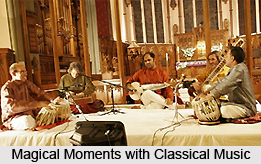 Alap in Indian music is an analysis of the Raagas. It possesses no metre and forms the opening section of a typical North Indian classical performance. In an instrumental performance and dhrupad alap is highly emphasized. Sometimes it lasts for more than an hour.
Alap in Indian music is an analysis of the Raagas. It possesses no metre and forms the opening section of a typical North Indian classical performance. In an instrumental performance and dhrupad alap is highly emphasized. Sometimes it lasts for more than an hour.
It is seen that many musicians perform alap schematically. Jor is a steady pulse that is introduced into the alap. Again when the tempo has been increased it is called jhala. Jor and jhala are considered as parts of the alap.
However, many musicologists have provided many classifications of alap. Some treat alap with a four-part scheme. Some researchers suggest classification by length and by performance style. Accordingly thirteen stages have been created and they are: Vilambit, Madhya, Drut, Jhala, Thok, Lari, Larguthav, Larlapet, Paran, Sath, Dhuya, Matha and Paramatha. In an Alap all the conditions of a Raga are observed like the starting or beginning of the "Raga" from particular note from a `sthayee,` `antara. `sanchari` and `abhog,` is supposed to be its main feature. Infact singing of alap is one of the ancient and original types of singing.
Alap is a slow rhythmic style in Indian music. They are classified based on the usage of words. Anakshar alap is where words are not used. If words are used then it is known as Sakshar Alap. Alap requires proper training as well as deep knowledge. Generally a vocal Alap is performed that is accompanied by Tambura and Sitar.
Forms of Alap
There are many forms of Alap, some with rhythm and some without rhythm. Alap that have rhythm may be linear or cyclic. The rhythmic part of the Alap may or may not be accompanied by a percussionist. The Alap may be long and elaborate or may be short. In most present day recitals, the Alap is an elaborate affair amongst many instrumentalists. The act of performing the Alap is called Alapchari. Earlier Alap and Vistar were known as Bhasha, Vibhasha, and Antarbhasha.
Svar Alap:
It is a form of Alap where the Raga is predominantly unfolded by an important note. Later it gradually progresses through its tonal centres.
Rag Alap
It is a form of Alap where the Raga is unfolded through its successive tonal centres. This is done by means of characteristic phrases of the Raga rather than by its individual important notes.
Auchar Alap
It is a short Alap that moves quickly through the important notes or phrases of the Raga, before going into the Bandish and continuing the Raga elaboration. Vistar or Badhat means rhythmless development of the Raga after the Bandish has been enunciated and while the rhythm cycle is maintained on the accompanying percussion instrument.
Poornang Alap
Alap when performed by vocalists like Dhrupad singers or some singers of the Gwalior Gharana or Agra Gharana it is known as Poornang Alap. This is the full and complete development of the Raga through Alap alone. It has four parts: Sthayi, Antara, Sanchari and Abhog.
Presentation of Alap
Alap is that improvisation on Vistar that uses all tools of ornamentation. A Sthayee of a Bandish is a compact Raaga representation itself and it establishes framework of the entire Raaga. Mukhada also plays an important role during a Raaga development. The role of Mukhada is to signify the end of each Alap.




